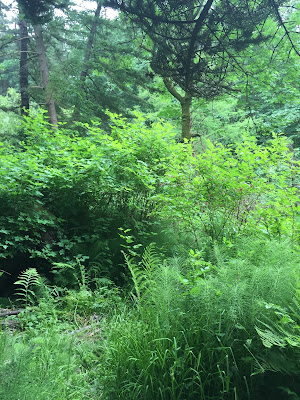Station 1: The Erratic boulder
This
boulder is well known to most people who frequent Ravenna Park, mainly because
it looks out of place. The Vashon lobe of the Cordilleran ice sheet moved the
boulder almost 20,000 years ago. The boulder sits in the creek that runs
through the bottom of the ravine. Since the boulder sits in water the
surrounding area is damp, making it a perfect place for moss to grow. There is
also a Pacific Yew (Taxus brevifolia)
that has lots of moss growing all over it. The Yew is a tree that does
well in moist areas, and usually have a handful of central trunks that branches
grow from. Traditionally, the Native
American tribes of the Pacific Northwest made paddles for canoes and bows for
hunting with the wood from the Yew.
Stations 2: Devils Club
Devils club
is an understory shrub that can be found mostly in old growth forests of the
North West. This spot in Ravenna Park is one of the only one can find Devil’s
club at in the entire park. It was not as tall as most of the Devil’s club I
came across with when visiting the more preserved old growth forest near
Crescent Lake, out on the Olympic Peninsula. The stems of the plant are of the
thicker variety when comparing it to other shrubs. It also has spines covering
most of the thick stems, with larger leaves extending out form the tops of the
stems.
Station 3: Picnic Area
The picnic
area is an example of an ecological disturbance caused by humans. Much of
Ravenna Park and the surrounding area was logged and clear-cut for human consumption
over the years. Over time conservationist have worked hard to try and preserve
the natural history of the park. On my walks through the park this quarter I
have come across countless instances of young native trees and shrubs being
planted in and efforts to further restore the natural ecosystem. There has also
been signs posted in areas where a conversation effort is taking place, to let
the general public know to take any extra precautions needed to ensure that the
restoration is successful. However, there often needs to be a balance between
conservation efforts and providing a recreational space for people in the
community.
Station 4: The Top of Ravenna Park Bridge
The top of
the bridge that crosses the top of the park is a great place to go bird
watching because the viewpoint is up in the canopy of the trees of the park. At
first glance the park seems to be dominated by the American Crow, and you can
constantly hear their loud caawing
call. On my first visit to the top of the bridge I was able to observe a group
of crows trying to drive out a couple of larger adult Bald Eagles. Bald Eagles
typically are found near larger bodies of water, where they can take advantage
of large supplies of fish. In addition to the larger birds just described there
are an abundance of smaller songbirds. The American Robin is one that someone
is almost guaranteed to hear and see while walking through the park, especially
in the early morning hours. They are found all over North America and can be
identified by the mahogany red-brown color of its breast. They can often be
seen on the forest floor feeding on worms, insects, and other invertebrates. A
slightly more rare bird I was able to come across from the vantage point at the
top of the bridge was a Golden Crowned Kinglet. It was sitting there perched on
the branch of a tall spruce or fir.
Station 5: The Creek Before the trail splits
















